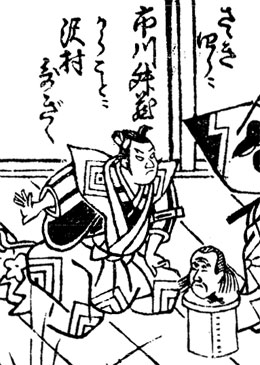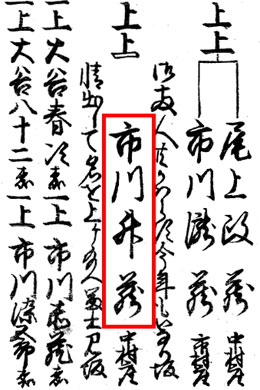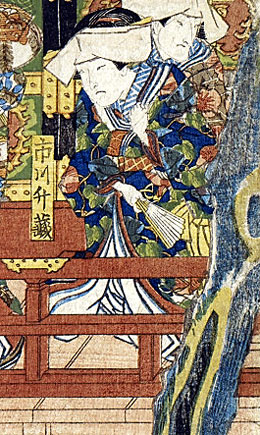| ICHIKAWA MASUZď |
| FOUR GENERATIONS [1] | |||||
| Ichikawa Masuz˘ I | |||||
|
The actor Ichikawa Raiz˘ I held the name of Ichikawa Masuz˘ I from the 11th lunar month of 1753 to the 10th lunar month of 1761. |
|||||
 |
|||||
|
Ichikawa Masuz˘ I playing the role of Sasaki Shir˘ in the drama "Keisei Kane-ni Sakura", which was staged in the 1st lunar month of 1756 at the Moritaza |
|||||
| Ichikawa Masuz˘ 1.2 Ichikawa Masuz˘ |
|||||
|
A minor katakiyaku actor held the name of Ichikawa Masuz˘ in Ky˘to from the 11th lunar month of 1767 to the 5th lunar month of 1778. No record afterwards. He was not considered as an official holder of the name. |
|||||
| Ichikawa Masuz˘ II | |||||
|
The actor Ichikawa Raiz˘ III held the name of Ichikawa Masuz˘ II from the 11th lunar month of 1779 to the 10th lunar month of 1788. |
|||||
 |
|||||
|
The name of Ichikawa Masuz˘ II in the 1782 Edo hy˘banki (the zone within the red box) |
|||||
| Ichikawa Masuz˘ 2.3 Ichikawa Masuz˘ |
|||||
|
A minor katakiyaku/jitsuaku actor held the name of Ichikawa Masuz˘ in ďsaka between 1789 and 1801. No record afterwards. |
|||||
| Ichikawa Masuz˘ 2.4 Ichikawa Masuz˘ |
|||||
|
A minor tachiyaku actor held the name of Ichikawa Masuz˘ in Kamigata between 1814 and 1820. No record afterwards. |
|||||
| Ichikawa Masuz˘ III [2] Ichikawa Masuz˘ III |
|||||
|
Dates of birth and death unknown. Disciple of Ichikawa Danjűr˘ VII, he started his career in the 11th month of 1800 in Edo at the Ichimuraza, where he made his debut on stage (hatsubutai) under the name of Ichikawa Yonez˘ II. He took the name of Ichikawa Kodanji III in the 11th month of 1816 at the Kawarasakiza. He took the name of Takigawa Danjűr˘ in the 1st lunar month of 1821 at the Nakamuraza. He took the name of Ichikawa Edohei in the 3rd lunar month of 1821 at the Nakamuraza. He reverted to the name of Ichikawa Kodanji III in the 1st lunar month of 1822 at the Ichimuraza, performing in the kaomise drama "Gohiiki Tsuwamono no Majiwari", which welcomed back Iwai Hanshir˘ V in Edo and celebrated the shűmei of Nakayama Kinsha. He took the name of Tsuruoka Hachiz˘ in the 5th lunar month of 1824 at the Ichimuraza, playing the role of Zenta in Tsuruya Nanboku IV's drama "Ehon Gapp˘-ga-Tsuji". He took the name of Ichikawa Hachiz˘ in the 11th lunar month of 1826 at the Ichimuraza, performing 2 roles in the kaomise drama "Ise Heiji Sh˘ no Kaomise". He finally took the name of Ichikawa Masuz˘ III [2] in the 11th lunar month of 1827 at the Ichimuraza, performing in the kaomise drama "Kawaranu Hana Genji no Kaomise". His last-recorded performance in Edo happened in the 3rd lunar month of 1833, at the Kawarasakiza, where he played in Tsuruya Nanboku IV's drama "Sumidagawa Hana no Goshozome". No record afterwards. He was a tachiyaku or katakiyaku supporting actor, who was equally at home in sewamono and jidaimono dramas. |
|||||
 |
|||||
|
Ichikawa Masuz˘ III performing in the drama "Sumidagawa Hana no Goshozome", which was staged in the 3rd lunar month of 1832 at the Ichimuraza (print made by Utagawa Kunisada I) |
|||||
| Ichikawa Masuz˘ 3.4 Ichikawa Masuz˘ |
|||||
|
A minor katakiyaku/jitsuaku actor held the name of Ichikawa Masuz˘ in Ky˘to between 1839 and 1841. No record afterwards. |
|||||
| Ichikawa Masuz˘ 3.5 Ichikawa Masuz˘ |
|||||
|
A minor tachiyaku actor held the name of Ichikawa Masuz˘ in Ky˘to between 1848 and 1856. No record afterwards. |
|||||
| Ichikawa Masuz˘ III Ichikawa Masuz˘ III |
|||||
|
Born in 1857. He was the son of a shibai jaya owner named Yoshiwara Hanki. Disciple of Kawarasaki Gonjűr˘ I, he started his career in 1864 and his first stage name was Yamazaki H˘saku. He took the name of Ichikawa Masuz˘ III in March 1880 at the Shintomiza. He passed the nadai exam in April 1901. He died the 6th of June 1906. He was the father of Ichikawa Masuz˘ IV. As he was very knowledgeable in Kagura, he was nicknamed Ged˘masu [3].
|
|||||
| Ichikawa Masuz˘ IV Tonegawa Kinjűr˘ |
|||||
|
Born the 2nd of February 1897. Son of Ichikawa Masuz˘ III, he started his career as a disciple of Ichikawa Danjűr˘ IX, who gave him the name of Ichikawa Kimitar˘. He made his debut in April 1902 at the Kabukiza. He passed the nadai exam in 1922 and took the name of Ichikawa Masuz˘ IV in June 1922 at the Imperial Theater, playing the roles of ďwashi Bungo and the monk Masub˘ in "Kanadehon Chűshingura" and "Kappore". He settled in 1928 in Kamigata, where he performed with Nakamura Ganjir˘ I. He stopped acting for a while at the end of WWII. He was back on stage in May 1957, when he became disciple of Ichikawa Ebiz˘ IX. He performed in April 1962 at the Kabukiza along with his master, who took the name of Ichikawa Danjűr˘ XI. He also played the role of a farmer for the revival of "Fud˘" in November 1962 at the Kabukiza. This was his last performance under the name of Ichikawa Masuz˘ IV as he angered his master in 1963 over a trivial thing. He had to give up his stage name and he became a free actor. With the support of Onoe Sh˘roku II, he took the original name of Tonegawa Kinjűr˘ [4] in September 1963, playing the roles of Hayami no T˘ta and Ushiz˘ in "Torii Mae" and "Fundoshi Isha". Kinjűr˘ was also chosen by this facetious actor for its similarity with Danjűr˘. His new yag˘, Murasakiya (the Purple Guild), was related to his favorite colour. He appeared on stage for the last time in February 1983 at the Kabukiza, where he played the role of the role of the kamikuzuya Borohachi in the drama "Shisen Ry˘ Koban no Ume-no-Ha". He retired and died the 22nd of January 1985 [5].
|
|||||
|
|
|||||
|
[1] 4 generations but 5 official holders of the name as there were two Ichikawa Masuz˘ III according to the latest edition (2012) of "Kabuki Haiyű Meiseki Benran". [2] Recorded as Ichikawa Masuz˘ II in Nojima Jusabur˘'s book "Kabuki Jinmei Jiten". [3] Ged˘ is a famous type of mask in Kagura. [4] We have to explain that Tonegawa is the Tone River, which flows near the cities of Narita (the origin of his former yag˘) and Ichikawa (the family name of his former master). [5] A few months before the shűmei of his former master's son Ichikawa Danjűr˘ XII. |
|||||
|
|
| Contact | Main | Top | Updates | Actors | Plays | Playwrights | Programs | Links | FAQ | Glossary | Chronology | Illustrations | Prints | Characters | Derivatives | Theaters | Coming soon | News |